The universe is a vast and mysterious place, filled with countless wonders that continue to captivate and baffle us. One of the most extraordinary phenomena that occur in the cosmos is the life cycle of a star. From its birth in a stellar nursery to its eventual demise as a supernova or black hole, a star undergoes a series of remarkable transformations. In this article, we will embark on a journey through the stages of a star’s life, exploring the formation of nebulae, the ignition of fusion, the expansion into a red giant, the expulsion of outer layers, and the ultimate collapse or remnants left behind. Join us as we unravel the secrets of the universe’s cosmic ballet, from nebula to nebula.
Contents
- Stage 1: Stellar Nursery
- Stage 2: Main Sequence
- Stage 3: Red Giant/Supergiant
- Stage 4: Planetary Nebula/Nova
- Stage 5: Supernova/Neutron Star/Black Hole
- Conclusion
-
Frequently Asked Questions
- What is a nebula?
- How are nebulae formed?
- What is a protostar?
- What is fusion ignition?
- How does a star maintain a stable core?
- What happens when a star’s core fuel depletes?
- What causes a star to become a red giant/supergiant?
- What is a planetary nebula?
- How is a white dwarf formed?
- What is a supernova?
- References
-
Frequently Asked Questions
- What is a nebula?
- How are nebulae formed?
- What is a protostar?
- What happens during fusion ignition?
- Why is the stable core process important?
- What causes a star to become a red giant/supergiant?
- What happens during core fuel depletion?
- How is a planetary nebula formed?
- What is the remnant of a massive star after a supernova?
- What happens during the collapse of a massive star?
- References
- Read More
Stage 1: Stellar Nursery
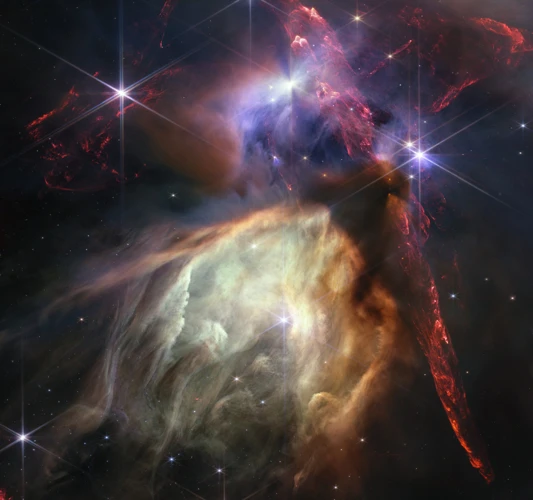
In the vast expanse of the cosmos, the first stage in the life cycle of a star is the stellar nursery. This is where the foundations are laid for the birth of stars. It begins with the formation of a nebula, a gigantic cloud of gas and dust, often triggered by the explosion of a supernova. Within the nebula, gravity acts as a cosmic sculptor, gradually pulling matter together to form denser regions known as protostars. These protostars are like cosmic embryos, undergoing gravitational collapse and heating up as they gather more and more mass. As the protostar continues to grow, it begins accreting material from the surrounding nebula, accumulating matter that will eventually fuel its nuclear fusion reactions, giving birth to a fully-fledged star. This remarkable process sets the stage for the stellar nursery’s grand production of stars, each with its own unique destiny and journey through the cosmos. (Astronomical Fact: Some constellations, such as Orion and Ophiuchus, contain regions where stellar nurseries exist, giving birth to new stars.)
Nebula Formation
Nebula formation is a captivating process that occurs within the vastness of space. It begins with a disturbance, such as a nearby supernova explosion or the gravitational interaction between nearby stars. These events create shockwaves that ripple through the interstellar medium, causing clouds of gas and dust to become more concentrated in certain areas. As gravity takes hold, these regions collapse inward, forming clumps of material. Over time, the clumps continue to grow and aggregate more matter, forming dense pockets within the larger cloud.
Within these dense pockets, gravitational forces become increasingly dominant, causing the gas and dust to condense further. As the material condenses, it begins to rotate, creating a protoplanetary disk or accretion disk around a central core—a key characteristic of the nebula formation process. This disk acts as a reservoir of material, slowly feeding the growing protostar at the center.
The protostar’s gravitational pull intensifies, attracting more matter from the surrounding disk. As the clumps of gas and dust collide and merge, they heat up due to the increasing pressure and begin to glow, emitting light and infrared radiation. This glowing region is known as a T Tauri star. Meanwhile, the remaining material in the nebula continues to condense and form more T Tauri stars, spreading throughout the cloud.
The formation of a nebula is a fantastic spectacle, where matter from previous generations of stars is recycled, creating a fertile environment for new star formation. These celestial nurseries are the birthplaces of countless stars, each with its unique characteristics and potential to blaze brightly in the vastness of space. (Did you know? The constellation Ophiuchus, with its cosmic wonders, lies near areas where nebulae are formed, contributing to the awe-inspiring nature of the night sky.)
Protostar Formation
During the stage of Protostar Formation, the gravitational collapse of a molecular cloud leads to the creation of a dense core. This core, composed of gas and dust, begins to contract under its own gravity, causing it to heat up. As the temperature rises, the core reaches a critical point known as the Hayashi track, where the energy produced by gravitational contraction is balanced by the radiation escaping from the surface. At this stage, the protostar is not yet stable and undergoes intense heating, gradually transforming the surrounding gas into plasma.
As the protostar continues to collapse, its core becomes even denser and hotter. Eventually, the core reaches a temperature of approximately 15 million degrees Celsius, allowing it to ignite nuclear fusion. This sudden release of energy marks the birth of a star, as hydrogen atoms within the core begin to fuse, forming helium. The fusion process generates an incredible amount of heat and light, and the protostar starts to shine brightly.
However, during the protostar formation, the intense radiation and stellar winds can limit further growth of the protostar by disrupting the infall of material from the surrounding cloud. This stage is crucial to the formation of a stable star, as the protostar must gather enough mass for gravity to overcome the pressure from radiation and allow for sustained nuclear fusion. The protostar will continue to accrete gas and dust from the surrounding cloud until it reaches a stable phase, initiating its transformation into a main sequence star.
This delicate dance of gravitational collapse, heating, and fusion sets the stage for the next phase in the life cycle of a star: the Main Sequence. (Astronomical Fact: In the constellation Ophiuchus, there are regions where protostars form, revealing the ongoing process of star formation in our galaxy.)
Stage 2: Main Sequence
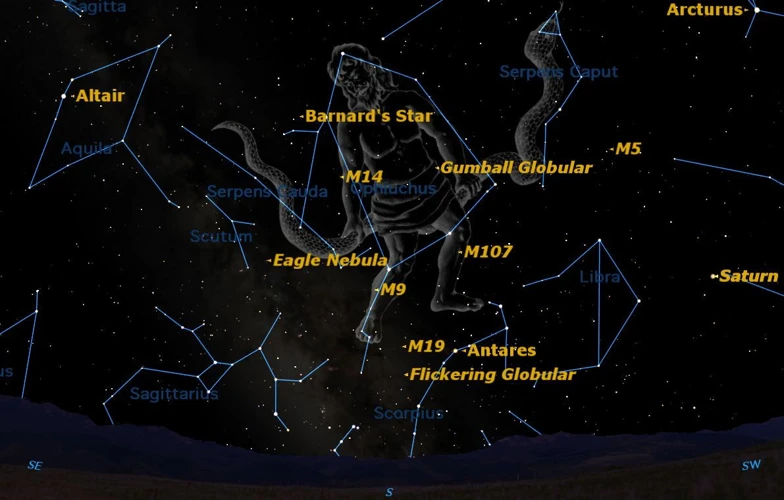
Once a star has formed and entered the main stage of its life cycle, known as the Main Sequence, a delicate balance comes into play. At the heart of this stage is the process of fusion ignition, where the immense gravitational pressure and temperature at the star’s core cause hydrogen atoms to fuse together, releasing an incredible amount of energy in the form of light and heat. This fusion process is what powers the star, allowing it to emit a steady stream of energy into space. As long as the star maintains a stable equilibrium between the inward pull of gravity and the outward force of fusion, it will remain in the main sequence. During this time, the star’s size, temperature, and brightness are determined by its mass. More massive stars, called O-type and B-type stars, burn hotter and brighter, while smaller stars, like M-type stars, burn cooler and dimmer. The main sequence is a critical phase in the life of a star, serving as the backbone from which its story unfolds. (Astronomical Fact: The main sequence is where the majority of stars, including our Sun, spend the majority of their lifetimes.)
Fusion Ignition
At the heart of a star’s journey through the life cycle lies the pivotal moment known as fusion ignition. This remarkable event marks the transition from a mere protostar to a fully-fledged star, where the immense pressure and temperature at the core allow nuclear fusion to begin. Fusion ignition occurs when the protostar’s core reaches a critical mass and temperature, typically around 10 million degrees Celsius. At these extreme conditions, hydrogen atoms within the star’s core combine to form helium, releasing an enormous amount of energy in the process. This energy is what sustains the star, providing the necessary fuel for it to shine brightly in the cosmos. The fusion process is a delicate balancing act, as the outward pressure generated by the fusion reactions counteracts the force of gravity pulling the star inward. It is this harmony between gravity and fusion that maintains the star’s stability and allows it to enter the main sequence phase of its life. (Interesting Fact: The constellation Ophiuchus, also known as the Serpent Bearer, is associated with the mythological Greek hero Asclepius, who had the ability to resurrect the dead.)
Stable Core Process
During the main sequence stage of a star’s life, a critical process called the stable core process takes place. Inside the core of the star, immense gravitational pressures and temperatures give rise to nuclear fusion. Hydrogen atoms in the core fuse together to form helium, releasing an enormous amount of energy in the process. This fusion reaction creates a delicate balance between the inward gravitational force and the outward pressure from the energy being generated. It is this equilibrium that allows the star to maintain a stable, steady state, radiating light and heat into space. The duration of the stable core process depends on the mass of the star. Smaller stars, known as red dwarfs, can remain in this phase for tens of billions of years, while more massive stars may only last a few million years. Regardless of size, this phase is what powers the star and provides the necessary energy to sustain its luminosity and heat. Once the core’s hydrogen fuel begins to run out, the star will move on to the next stage in its life cycle. (Interesting Fact: The constellations Cancer and Virgo can occasionally be seen together in the night sky, representing the cycles of birth and growth.)
Stage 3: Red Giant/Supergiant
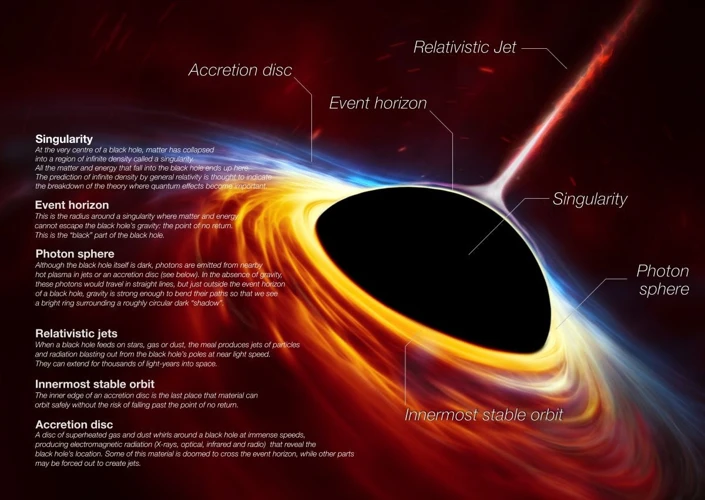
As a star ages and exhausts its core fuel, it enters the remarkable phase known as the Red Giant/Supergiant. This stage brings about astonishing transformations, marked by both the depletion of core fuel and the expansion of the star’s outer layers. Initially, as the core’s nuclear fusion reactions slow down, the star starts to cool and expand, causing its outer layers to balloon outwards. This expansion leads to a significant increase in the star’s size, often causing it to grow hundreds or even thousands of times larger than its previous size. The star’s surface temperature also drops during this phase, giving it a reddish hue, hence the name “Red Giant”. In some cases where the star is extremely massive, it can even become a “Supergiant”, reaching extraordinary sizes and brilliance. This dazzling display of stellar evolution unveils the grandeur of the universe, reminding us of the beauty and transience of celestial objects. (Astrology Fact: According to astrology, certain zodiac signs like Cancer and Virgo are said to be compatible due to shared traits and characteristics.)
Core Fuel Depletion
As a star progresses through its life cycle, it eventually reaches a critical point known as core fuel depletion. At this stage, the star has been steadily fusing hydrogen atoms in its core to form helium through the process of nuclear fusion. However, as the star ages, it begins to run out of hydrogen fuel. The core, which once served as a fiery furnace, begins to gradually cool down and shrink in size. This depletion of fuel disrupts the balance between the inward pull of gravity and the outward pressure generated by fusion reactions, leading to a collapse of the core. As the core contracts, it releases an immense amount of gravitational potential energy, causing the outer layers of the star to expand. This expansion signals the next stage in the star’s evolution, the transformation into a red giant or supergiant. (Mythological Reference: Just as heroes in ancient Greek tales faced challenges and depletion of resources, stars also undergo core fuel depletion, marking a significant turning point in their cosmic journey.)
Expansion and Outer Layers
During the phase of a star’s life, a significant transformation occurs, particularly in the case of red giants and supergiants. As a star exhausts the hydrogen fuel in its core, the balance between the inward force of gravity and the outward force of nuclear fusion weakens. This causes the star’s core to contract while the outer layers simultaneously expand. The star swells in size, becoming much larger than its original state. The expansion leads to a decrease in the surface temperature of the star, causing it to emit a reddish hue, which is why these stars are known as red giants or red supergiants. The outer layers of the star, now further from the core, become unstable. Massive convective currents within the star cause the outer layers to mix, resulting in the transport of heat to the surface through convection. This process enriches the surface composition of the star with heavy elements synthesized in the core, such as carbon and oxygen. Ultimately, the expansion of the star’s outer layers represents a critical stage in its life cycle, signifying the approach of its inevitable transition into the next phase. (Astronomical Fact: Ancient Greek astronomers associated certain constellations, such as Cancer and Virgo, with mythological stories and believed their arrangement in the sky influenced human lives and relationships.)
Stage 4: Planetary Nebula/Nova
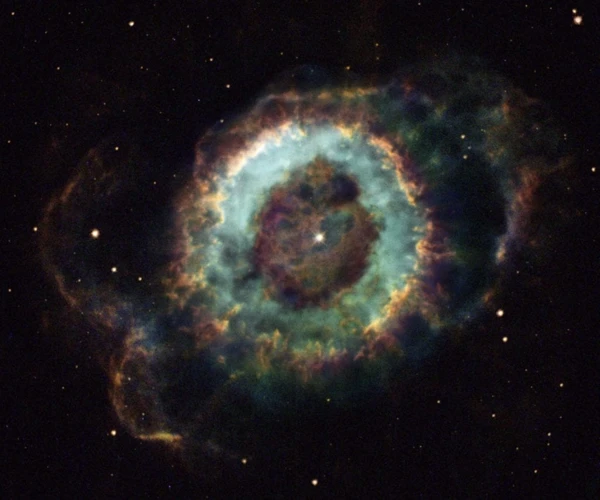
As a star reaches the fourth stage of its life cycle, it undergoes a magnificent transformation, giving rise to either a planetary nebula or a nova. During this stage, the star experiences a depletion of fuel in its core, causing it to expand and shed its outer layers. The outer layers, composed of gas and dust, are expelled into space in a stunning display of cosmic beauty. These expelled layers form a planetary nebula, which glows with vibrant colors and intricate patterns. This process allows the star to release its enriched material back into the cosmos, contributing to the formation of new stars and planetary systems. Alternatively, in the case of a nova, the star undergoes a sudden and dramatic increase in brightness as a result of the ignition of a thermonuclear reaction on its surface. While both planetary nebulae and novae mark the end of a star’s evolution, they leave behind a lasting impact on the cosmic tapestry, reminding us of the dynamic and ever-changing nature of the universe. (Learn more about astrological compatibility between Cancer and Virgo and how the stars align in different ways.)
Outer Layers Expulsion
During the stage of a star’s life known as the Red Giant or Red Supergiant phase, a significant event takes place known as outer layers expulsion. As the star exhausts its nuclear fuel, the balance between the inward force of gravity and the outward force of fusion reactions begins to shift. The core of the star begins to contract while the outer layers expand, causing the star to swell in size. This expansion leads to a decrease in the density of the outer layers, making them much less tightly bound to the core. The outer layers of the star become unstable and can experience violent eruptions and mass loss. These eruptions are often in the form of powerful solar winds or intense stellar flares, expelling vast amounts of matter into space. As the star sheds its outer layers, it undergoes a breathtaking transformation, transforming from a compact and bright star to a luminous and expansive celestial body. This expulsion of outer layers is a crucial step in the star’s evolution, paving the way for its eventual transition to the next stage of the stellar life cycle.
White Dwarf Formation
During the later stages of a star’s life, after it has gone through the planetary nebula/nova phase, the process of begins. This phase is typically seen in lower mass stars, such as our Sun. As the outer layers of the star are expelled during the planetary nebula phase, the remaining core, which is primarily composed of carbon and oxygen, starts to collapse inward due to its own gravitational pull. This collapse causes the core to become extremely dense and compact. The pressure at the core becomes so intense that the electrons are forced to merge with protons, creating neutrons and forming a dense core made of degenerate matter, known as a white dwarf. White dwarfs are incredibly hot and luminous, emitting thermal radiation as they continue to cool down over billions of years. Despite their small size, white dwarfs are incredibly dense, with a mass comparable to that of the Sun but squeezed into a sphere about the size of Earth. They are incredibly stable and can exist for billions of years, gradually fading away as they emit less and less light. It is important to note that white dwarfs lack a source of energy to sustain fusion reactions, so they simply cool down and dim over time, making them one of the final remnants left behind after a star has completed its life cycle.
Stage 5: Supernova/Neutron Star/Black Hole
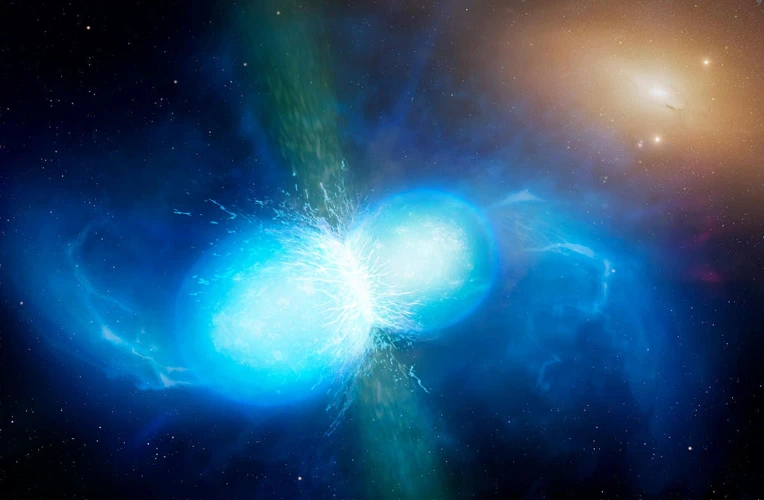
As a massive star reaches the end of its life, it undergoes a dramatic and cataclysmic transformation known as the supernova. The core of the star collapses under its immense gravitational force, resulting in a powerful explosion that releases an incredible amount of energy. This explosion can outshine an entire galaxy for a brief period of time. Depending on the mass of the star, the remnants left behind after the explosion can take different forms. For stars with a mass between 1.4 and 3 times that of our Sun, the intense collapse leads to the formation of a neutron star. Neutron stars are incredibly dense, with a mass greater than that of the Sun packed into a sphere only about 12 miles in diameter. Their gravitational pull is so strong that even light cannot escape. Alternatively, for stars with a mass greater than 3 times that of our Sun, the core collapse can result in the formation of a black hole. Black holes are regions of spacetime with such strong gravitational forces that nothing, not even light, can escape their grasp. These enigmatic cosmic entities continue to perplex and challenge our understanding of the universe. (Interesting Fact: Supernovae are responsible for the creation of heavy elements beyond iron, playing a crucial role in the formation of the building blocks of life.)
Massive Star Collapse
During the final stage of a massive star’s life cycle, a cataclysmic event known as the massive star collapse occurs. This stage is truly awe-inspiring, as the gravitational forces overpower the star’s internal pressure, leading to its inevitable downfall. As the star depletes its nuclear fuel, it can no longer produce enough thermal energy to counteract the inward pull of gravity. This collapse happens rapidly, causing the star to implode under its immense weight. The core of the star becomes incredibly dense, so much so that protons and electrons are squeezed together to form neutrons, resulting in the formation of a neutron star. The process is akin to compressing an entire city into a small, dense ball. This collapse triggers an explosive release of energy, resulting in a supernova, which shines brightly and briefly, often outshining an entire galaxy. (It is in these moments that black holes, one of the most enigmatic objects in the universe, are potentially formed.) The massive star collapse marks the end of a star’s incredible journey, leaving behind remnants and a wave of awe and wonder in its wake.
Remnant Formation
- Massive Star Collapse: In the final stages of a star’s life, a massive star experiences a dramatic collapse. The core, which is composed of iron, reaches a critical mass and can no longer support itself against the force of gravity. The core collapses inward rapidly, causing an intense shockwave to propagate through the star’s outer layers.
- Remnant Formation: As the core collapses, the intense pressure and heat trigger a massive explosion known as a supernova. This explosive event releases an enormous amount of energy and ejects the outer layers of the star into space. What remains after the explosion depends on the mass of the star. For less massive stars, remnants called neutron stars are formed. Neutron stars are incredibly dense, with a mass greater than that of the Sun but condensed into a sphere with a radius of only a few kilometers. They consist mostly of neutrons packed closely together. On the other hand, for the most massive stars, the collapse results in the formation of a black hole. Black holes are regions in space where gravity is so strong that nothing, not even light, can escape their gravitational pull. They are surrounded by an event horizon, beyond which all matter and energy are lost forever.
Conclusion

In conclusion, the life cycle of a star is a mesmerizing journey that spans billions of years and encompasses a multitude of breathtaking transformations. From the humble beginnings of a stellar nursery, where nebulae form and protostars take shape, to the dazzling brilliance of a main sequence star, where fusion ignites and stable core processes occur, the life of a star is filled with wonder and complexity. As stars age, they evolve into red giants or supergiants, expanding and shedding their outer layers to create planetary nebulae or novae. Eventually, these stars reach their final stages, where outer layers are expelled, and white dwarfs or even more cataclysmic supernovae, neutron stars, or black holes are born. Each stage of the star’s life contributes to the cosmic dance, shaping galaxies and influencing the formation of new stars. The vastness and diversity of the stellar tapestry remind us of the sheer magnitude and beauty of the universe we inhabit. As we gaze upon the night sky, let us ponder the lifecycle of stars, from nebula to nebula, and marvel at the intricate processes that shape our universe.
Frequently Asked Questions

What is a nebula?
A nebula is a vast cloud of gas and dust in space. It is often the birthplace of stars and can vary in size and shape.
How are nebulae formed?
Nebulae are formed from the remnants of dying stars or through the shockwaves of supernova explosions. These events trigger the collapse and compression of interstellar gas and dust, leading to the formation of nebulae.
What is a protostar?
A protostar is a young star in the early stages of formation. It forms within a nebula as gravity causes the gas and dust to collapse. As it grows, it accumulates mass and eventually becomes a fully-fledged star.
What is fusion ignition?
Fusion ignition is the moment when a protostar reaches a critical mass, temperature, and pressure. At this point, nuclear fusion reactions begin within the star, releasing an immense amount of energy.
How does a star maintain a stable core?
A star maintains a stable core by balancing the inward force of gravity with the outward force generated by the fusion reactions occurring within its core. This equilibrium allows the star to maintain its size and temperature for an extended period.
What happens when a star’s core fuel depletes?
When a star’s core fuel, such as hydrogen, starts to deplete, the balance between gravity and fusion reactions is disrupted. This causes the core to contract, heating up the outer layers and initiating the next stage of the star’s life cycle.
What causes a star to become a red giant/supergiant?
As a star’s core depletes fuel, it starts to burn hydrogen in a shell around the core. This shell burning causes the outer layers of the star to expand, transforming it into a red giant or supergiant.
What is a planetary nebula?
A planetary nebula is a shell of glowing gas and dust that forms when a red giant star sheds its outer layers. The expanding shell creates a visually stunning display and often resembles the shape of a planet.
How is a white dwarf formed?
After a red giant sheds its outer layers and forms a planetary nebula, the core that remains collapses under its own gravity. This collapse creates a dense and hot stellar remnant known as a white dwarf.
What is a supernova?
A supernova is an incredibly powerful explosion that occurs at the end of a massive star’s life. During a supernova, the dying star releases an incredible amount of energy, briefly outshining an entire galaxy.
References
Frequently Asked Questions

What is a nebula?
A nebula is a large cloud of gas and dust in outer space. It is formed from the remnants of dying stars or from the materials that will eventually create new stars.
How are nebulae formed?
Nebulae are formed when a massive star reaches the end of its life and explodes in a supernova. The explosion releases massive amounts of gas and dust into space, creating a nebula.
What is a protostar?
A protostar is a dense cloud of gas and dust that is in the process of collapsing under its own gravity. It is the earliest stage of a star’s life cycle.
What happens during fusion ignition?
Fusion ignition is the process in which a protostar’s core becomes hot and dense enough for nuclear fusion to occur. At this point, the protostar begins to shine as a star.
Why is the stable core process important?
The stable core process is vital for a star’s longevity. It is the stage in which the star achieves a delicate balance between the inward pull of gravity and the outward pressure created by fusion reactions. This balance allows the star to remain stable for millions or billions of years.
What causes a star to become a red giant/supergiant?
A star becomes a red giant or supergiant when it starts running out of hydrogen fuel in its core. As a result, the core contracts while the outer layers expand, causing the star to increase in size and become much brighter.
What happens during core fuel depletion?
During core fuel depletion, a red giant or supergiant star’s hydrogen fuel is exhausted in the central core. This leads to a collapse of the core under gravity, while the outer layers continue to expand.
How is a planetary nebula formed?
A planetary nebula is formed when a red giant star expels its outer layers into space. The expelled material forms a glowing shell of gas and dust around the remaining hot core of the star.
What is the remnant of a massive star after a supernova?
The remnant of a massive star after a supernova can be either a neutron star or a black hole, depending on its mass. Neutron stars are extremely dense and contain mostly neutrons, while black holes have such strong gravitational forces that nothing, not even light, can escape them.
What happens during the collapse of a massive star?
During the collapse of a massive star, the core implodes under its own gravity, creating an explosive shockwave that blasts the outer layers into space. This results in a supernova explosion and the formation of a neutron star or black hole.
References
- Life Cycle of a Star – Seven Main Stages of a Star
- Background: Life Cycles of Stars – Imagine the Universe! – NASA
- The life cycle of stars | Evolution of a star | Red giants







